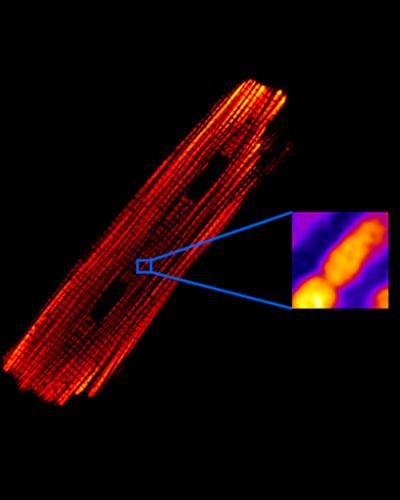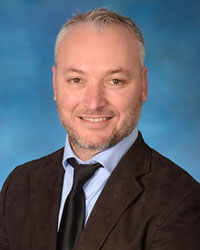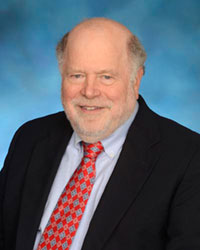February 19, 2020 | Deborah Kotz

How Do Cells Know When They Need to Increase Energy Production? Study Clarifies a Once Elusive Process
Researchers at the University of Maryland School of Medicine (UMSOM) identified an important regulatory mechanism by which cells control the production of ATP, a universal energy-rich chemical that enables our brains to think, our muscles to contract, and our hearts to beat.
In a recent set of findings published in the journal Nature Metabolism, the researchers found that cells have an elegant mechanism for determining when ATP production needs to be ramped up to meet the increased energy demands required by an activity of an organ, a tissue or a cell.
“We looked specifically at heart cells and determined how they communicate with their numerous subcellular microscopic power factories, the mitochondria, to produce more ATP,” said study corresponding author Liron Boyman, PhD, a Research Associate in Physiology at UMSOM.
“We found that the first critical signal comes from rising levels of an ATP "waste product" called ADP, which is produced when cells are active and consuming ATP. Additionally, a second signal acts in concert with rising ADP in the heart cell and this signal is elevated calcium within the mitochondria.”
These two factors work in tandem to alert the cell that it needs to produce more energy.

They characterized how calcium enters mitochondria and found that it activates two specific enzymatic pathways, which use the energy stored in specific types of foods -- carbohydrates and proteins. The resulting enhanced production of ATP preferentially consumes carbohydrates and proteins to keep the voltage of the mitochondrial inner membrane at a high level. This voltage is the key power source used to make ATP.
“Maintaining this large voltage is necessary to enable robust production of ATP in the mitochondria to match the energy needs of the cell,” said study co-author Jonathan Lederer, MD, PhD, a Professor of Physiology at UMSOM and Director of the Center for Biomedical Engineering & Technology. “While this mechanism had long been suspected, we provided the first quantitative evidence showing how the system works and identified what specific components do to make this elegant process hum.”

Understanding the process of ATP production may prove crucial to developing new treatments for mitochondrial diseases where inadequate energy is produced by the mitochondria and other aspects of mitochondrial signaling go awry. These can include rare inherited conditions, like progressive myoclonic epilepsy, and also more prevalent acquired conditions like heart failure, Alzheimer’s disease, Lou Gehrig’s disease, diabetes, and muscular dystrophy.
“This is an exciting finding that highlights the importance of basic research and its potential to identify new approaches for treating debilitating diseases,” said UMSOM Dean E. Albert Reece, MD, PhD, MBA, University Executive Vice President for Medical Affairs and the John Z. and Akiko K. Bowers Distinguished Professor. “It would not have been possible without the innovations made by the research team that enabled them to make finely-tuned measurements inside the mitochondria of a single cell.”
The researchers are next planning to study brain cells and ATP production with the hope of ultimately determining how mitochondrial dysfunction may contribute to the onset of Alzheimer’s disease.
This research was supported by grants from the National Institutes of Health and the American Heart Association.
About the University of Maryland School of Medicine
Now in its third century, the University of Maryland School of Medicine was chartered in 1807 as the first public medical school in the United States. It continues today as one of the fastest growing, top-tier biomedical research enterprises in the world -- with 45 academic departments, centers, institutes, and programs; and a faculty of more than 3,000 physicians, scientists, and allied health professionals, including members of the National Academy of Medicine and the National Academy of Sciences, and a distinguished two-time winner of the Albert E. Lasker Award in Medical Research. With an operating budget of more than $1.2 billion, the School of Medicine works closely in partnership with the University of Maryland Medical Center and Medical System to provide research-intensive, academic and clinically based care for nearly 2 million patients each year. The School of Medicine has more than $540 million in extramural funding, with most of its academic departments highly ranked among all medical schools in the nation in research funding. As one of the seven professional schools that make up the University of Maryland, Baltimore campus, the School of Medicine has a total population of nearly 9,000 faculty and staff, including 2,500 student trainees, residents, and fellows. The combined School of Medicine and Medical System (“University of Maryland Medicine”) has an annual budget of nearly $6 billion and an economic impact more than $15 billion on the state and local community. The School of Medicine faculty, which ranks as the 8th highest among public medical schools in research productivity, is an innovator in translational medicine, with 600 active patents and 24 start-up companies. The School of Medicine works locally, nationally, and globally, with research and treatment facilities in 36 countries around the world. Visit medschool.umaryland.edu
Contact
Office of Public Affairs
655 West Baltimore Street
Bressler Research Building 14-002
Baltimore, Maryland 21201-1559
Contact Media Relations
(410) 706-5260
Deborah Kotz
Director of Media Relations
Office of Public Affairs & Communications
University of Maryland School of Medicine
o: 410-706-4255
c: 410-804-0054
t: @debkotz2
